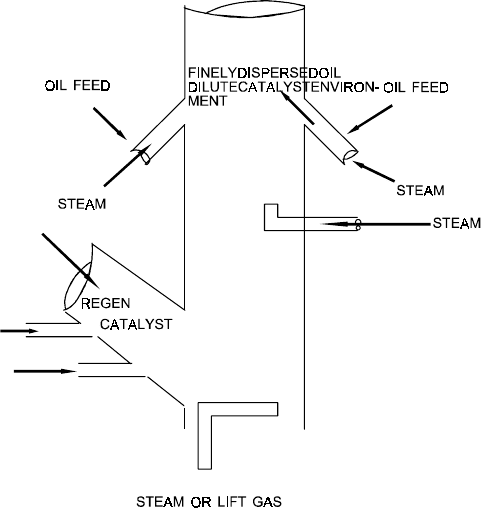Jones D.S.J., Pujado P.R. Handbook of Petroleum Processing
Подождите немного. Документ загружается.


1176 CHAPTER 19
where
U
o
= overall heat transfer coefficient based on outside tube surface,
in Btu/hr/sqft/
◦
F.
h = The film coefficient in Btu/hr/sqft/
◦
F.
r
f
= fouling factors in
1
Btu/hr/sqft/
◦
F
h
w
= Heat transfer rate through tube wall in Btu/hr/sqft/
◦
F.
A = Surface area in sqft
subscripts “o”and “i”refer to outside surface and inside surface, respectively.
Flow arrangements. The two more common flow paths are concurrent and counter-
current. In concurrent flow both the hot fluid and the cold fluid flow in the same
direction. This is the least desirable of the flow arrangement and is only used in those
chemical processes where there is a danger of the cooling fluid congealing, subliming,
or crystallizing at near ambient temperatures.
Countercurrent flow is the most desirable arrangement. Here the hot fluid enters at
one end of the exchanger and the cold fluid enters at the opposite end. The streams
flow in opposite directions to one another. This arrangement allows the two streams
exit temperatures to approach one another.
Logarithmic mean temperature difference t
m
. In either countercurrent or concurrent
flow arrangement the log mean temperature difference used in the overall heat transfer
equation is determined by the following expression:
t
m
=
t
1
− t
2
log
e
t
1
t
2
The t’s are the temperature differences at each end of the exchanger and t
1
is the
larger of the two. In true countercurrent flow the t
m
calculated can be used directly
in the overall heat transfer equation. However such a situation is not common and true
countercurrent flow rarely exists. Therefore a correction factor needs to be applied
to arrive at the correct t
m
. These are given in Figure 18.A.1 in the appendix to
Chapter 9. Details of the shell and tube exchangers including the following:
r
Choice of tube side or shell side fluid
r
Calculation methods
r
Shell and tube baffling
r
Types of shell and tube exchangers (fixed sheet, floating head etc.)
are also given in Chapter 18.
Air coolers and condensers. Air cooling of process streams or condensing of process
vapors is more widely used in the process industry than cooling or condensing by
A DICTIONARY OF TERMS AND EXPRESSIONS 1177
exchange with cooling water. The use of individual air coolers for process streams
using modern design techniques has economized in plant area required. It has also
made obsolete those large cooling towers and ponds associated with product cooling.
As in the case for shell and tube exchangers there are many excellent computer
programs that can be used for the design of air coolers. A method given in Chapter 9
for such calculation may be used in the absence of a computer program or for a good
estimate of a unit.
A general description and diagrams of the two types of air coolers which are forced
air flow and induced air flow has already been given under item “Air Coolers”earlier
in this part of the Handbook.
Thermal rating. Thermal rating of an air cooler is similar in some respects to that for
a shell and tube described in the previous item. The basic energy equation
Q = U TA
is used to determine the surface area required. The calculation for U is different in
that it requires the calculation for the air side film coefficient. This film coefficient is
usually based on an extended surface area which is formed by adding fins to the bare
surface of the tubes. Thermal rating, surface area, fan dimensions, and horsepower
are calculation are given in full in Chapter 18 of this Handbook.
Condensers. In petroleum refining and most other chemical process plants vapors are
condensed either in the shell side of a shell and tube exchanger, the tube side of an air
cooler, or by direct contact with the coolant in a packed tower. By far the most common
of these operations are the first two listed. In the case of the shell and tube condenser
the condensation may be produced by cooling the vapor by heat exchange with a cold
process stream or by water. Air cooling has overtaken the shell and tube condenser
in the case of water as coolant in popularity as described in the previous item.
In the design or performance analysis of condensers the procedure for determining
thermal rating and surface area is more complex than that for a single phase cooling
and heating. In condensers there are three mechanisms to be considered for the rating
procedure. These are:
r
The resistance to heat transfer of the condensing film
r
The resistance to heat transfer of the vapor cooling
r
The resistance to heat transfer of the condensate film cooling
Each of these mechanisms is treated separately and along preselected sections of the
exchanger. The procedure for determining the last two of the mechanisms follows
that described earlier for single phase heat transfer. The following expression is used

1178 CHAPTER 19
to calculate the film coefficient for the condensing vapor:
h
.33
c
=
8.33
3
× 10
2
µ
f
0.33
× k
f
×
Sg
c
(M
c
/L
c
· N
s
)
where
h
c
= Condensing film coefficient.
M
c
= Mass condensed in lbs/hr
L
c
= Tube length for condensation.
=
A
zone
× (L − 0.5)
A
N
s
= 2.08 N
0.495
t
for triangular pitch.
k
f
= Thermal conductivity of condensate at film temperature.
S
g
= Specific gravity of condensate.
µ
f
= Viscosity of condensate at film temperature in Cps
Again there are many excellent computer programs that calculate condenser thermal
ratings, and these of course save the tedium of the manual calculation.
As in the case of the shell and tube exchanger and the air cooler a manual calculation
for condensers is described in Chapter 18 of this Handbook. Again this is done to
provide some understanding of the data required to size such a unit and its significance
in the calculation procedure. Computer aided designs should however be used for these
calculations whenever possible.
Heavy oil cracking
Up to the late 1980s feedstock to FCCU were limited by characteristics such as high
Conradson carbon and metals. This excluded the processing of the “bottom of the
barrel”residues. Indeed, even the processing of vacuum gas oil feeds was limited to
Conradson carbon < 10 wt%
hydrogen content < 11.2 wt%
metals N1 + V < 50 ppm
During the late 1980s significant research and development breakthroughs have pro-
duced a catalytic process that can handle residuum feed.
Feed stocks heavier than vacuum gas oil in conventional FCCU tend to increase the
production of coke and this in turn deactivates the catalyst. This is mainly the result
of:
r
A high portion of the feed that does not vaporize. The unvaporized portion quickly
cokes on the catalyst choking its active area.
A DICTIONARY OF TERMS AND EXPRESSIONS 1179
r
The presence of high concentrations of polar molecules such as poly-cyclic aro-
matics and nitrogen compounds. These are absorbed into the catalyst’s active area
causing instant (but temporary) deactivation.
r
Heavy metals contamination that poison the catalyst and affect the selectivity of the
cracking process.
r
High concentration of poly-naphthenes that dealkylate slowly.
In FCCU that process conventional feedstocks cracking temperature is controlled by
the circulation of hot regenerated catalyst. With the heavier feedstocks an increase in
Conradson carbon will lead to a larger coke formation. This in turn produces a high
regenerated catalyst temperature and heat load. To maintain heat balance therefore
catalyst circulation is reduced leading to poor or unsatisfactory performance. Catalyst
cooling or feed cooling is used to overcome this high catalyst heat load and to maintain
proper circulation.
The extended boiling range of the feed as in the case of residues tends to cause an
uneven cracking severity. The lighter molecules in the feed are instantly vaporized
on contact with the hot catalyst, and cracking occurs. In the case of the heavier
molecules vaporization is not achieved so easily. This contributes to a higher coke
deposition with a higher rate of catalyst deactivation. Ideally the whole feed should be
instantly vaporized so that a uniform cracking mechanism can commence. The mix
temperature (which is defined as the theoretical equilibrium temperature between the
uncracked vaporized feed and the regenerated catalyst) should be close to the feed
dew point temperature. In conventional units this is about 20–30
◦
C above the riser
outlet temperature. This can be approximated by the expression:
T
M
= T
R
+ 0.1 Delta H
C
where
T
M
= the mix temperature
T
R
= riser outlet temperature
◦
C
Delta H
C
= heat of cracking in kJ/kg
This mix temperature is also slightly dependent on the catalyst temperature.
Cracking severity is affected by poly-cyclic aromatics and nitrogen. This is so
because these compounds tend to be absorbed into the catalyst. Rising the mix
temperature by increasing the riser temperature reverses the absorption process.
Unfortunately, a higher riser temperature leads to undesirable thermal cracking and
production of dry gas.
The processing of resid feedstocks therefore requires special techniques to overcome:
r
Feed vaporization
r
High concentration of polar molecules
r
Presence of metals
1180 CHAPTER 19
Some of the techniques developed to meet heavy oil cracking processing are as
follows:
r
Two stage regeneration
r
Riser mixer design and mix temperature control (for rapid vaporization)
r
New riser lift technology minimizing the use of steam
r
Regen catalyst temperature control (catalyst cooling)
r
Catalyst selection for:
➢ Good conversion and yield pattern
➢ Metal resistance
➢ Thermal and hydrothermal resistance
➢ High gasoline RON
Conventional fluid catalytic crackers can be revamped to incorporate the features
necessary for heavy oil (residual) cracking.
An important issue in the case of deep oil (residue) cracking is the handling of the
high coke lay down and the protection of the catalyst. One technique that limits the
severe conditions in regeneration of the spent catalyst is the two stage regeneration.
Figure 11.11 in Chapter 11 shows this configuration.
The spent catalyst from the reactor is delivered to the first regenerator. Here the
catalyst undergoes a mild oxidation with a limited amount of air. Temperatures in this
regeneration remain fairly low around 700–750
◦
C range. From this first regeneration
the catalyst is pneumatically conveyed to a second regenerator. Here excess air is used
to complete the carbon burn off and temperatures up to 900
◦
C are experienced. The
regenerated catalyst leaves this second regeneration to return to the reactor via the riser.
The technology that applies to the two stage regeneration process is innovative in
that it achieves burning off the high coke without impairing the catalyst activity.
In the first stage the conditions encourage the combustion of most of the hydrogen
associated with the coke. A significant amount of the carbon is also burned off under
mild condition. These conditions inhibit catalyst deactivation.
All the residual coke is burned off in the second stage with excess air and in a
dry atmosphere. All the steam associated with hydrogen combustion and carry over
from the reactor has been dispensed within the first stage. The second regenerator
is refractory lined and there is no temperature constraint. The catalyst is allowed to
come to equilibrium. Even at high regen temperatures under these conditions lower
catalyst deactivation is experienced. The two stage regeneration technique leads to
a better catalyst regeneration as well as a lower catalyst consumption. Typically the
clean catalyst contains less than 0.05 wt% of carbon. This is achieved with an overall
lower heat of combustion. Full details of this concept are given in Chapter 11. Since
the unit remains in heat balance coke production stays essentially the same. The

A DICTIONARY OF TERMS AND EXPRESSIONS 1181
circulation rate of catalyst adjusts itself to any changes in coke deposition on the
catalyst according to the expressions:
coke make = delta coke + c/o
and
regenerator temperature = riser temperature +C × delta coke
where
delta coke = difference between the weight fraction of coke on the catalyst
before and after regeneration.
c = unit constant (typically 180–230)
c/o = catalyst to oil ratio
In this regard a small circulation of extremely hot catalyst may not be effective as a
large circulation of cooler catalyst. It has been found that there is a specific catalyst
temperature range that is desirable for a given feed and catalyst system. A unique
dense phase catalyst cooling system provides a technique through which the best
temperature and heat balance relationship can be maintained.
Consider the enthalpy requirements for a FCC reactor given in the following table:
Per pound of feed
Btu %
Feed heating/vaporizing 530.0 69.00
Stripping steam enthalpy 5.0 0.65
Feed steam for dispersion 12.7 1.65
Feed water for heat balance 18.4 2.40
Heat of reaction 200.0 26.04
Heat loss 2.0 0.26
Total 768.1 100.00
It can be seen from this table that 69% of the enthalpy contained in the heat input to
the reactor is required just to heat and vaporize the feed. The remainder is essentially
available for conversion. To improve operation it would be desirable to allow more of
the heat available to be used for conversion. The only variable that can be changed to
achieve this requirement is the feed inlet enthalpy. That is through preheating the feed.
Doing this, however, immediately reduces the catalyst circulation rate to maintain heat
balance. This of course has an adverse effect on conversion. The preheating of the
feed can, however, be compensated for by cooling the catalyst. Thus the catalyst
circulation rate can be retained and in many cases can be increased. Indeed, by careful
manipulation of the heat balance the net increase in catalyst circulation rate can be as
high as 1 unit cat/oil ratio. The higher equilibrium catalyst activity possible at the lower

1182 CHAPTER 19
regeneration temperature also improves the unit yield pattern. This is demonstrated
in the following table:
Feedstock
◦
API 24.5
Conradson carbon 1.6
Yields
Without catalyst With catalyst
cooling cooling
H
2
S wt% 0.1 0.19
C
2
− wt% 3.4 2.00
C
3
LV% 9.9 10.34
C
4
LV% 13.9 14.51
C
5
+ (430:EP) LV% 58.2 60.87
LCO (650:EP) LV% 17.1 15.54
CLO LV% 8.6 8.10
Coke wt% 5.9 6.07
Conversion LV% 74.3 76.36
In summary, catalyst cooling will:
r
Slightly increase unit coke
r
Give a higher plant catalyst activity
r
Be able to handle more contaminated feeds
r
Improve conversion and unit yield
r
Provide better operating flexibility
In residue cracking commercial experience indicates that operations at regenerated
catalyst temperatures above 1,350
◦
F result in poor yields with high gas production.
Where certain operations require high regenerator temperatures the installation of a
catalyst cooler will have a substantial economic incentive. This will be due to improved
yields and catalyst consumption.
There are two types of catalyst coolers available. These are shown as Figure 11.14 in
Chapter 11. They are:
r
The back mix type
r
Flow through type
Both coolers are installed into the dense phase section of the regenerator.
The back mix cooler. Boiler feed water flows tube side in both cooler types. The
catalyst in the back mix cooler circulates around the tube bundle on the shell side.

A DICTIONARY OF TERMS AND EXPRESSIONS 1183
The heat transfer takes place in a dense low velocity region so erosion is minimized.
The back mix cooler can remove approximately 50 million Btu’s/hr.
The flow through cooler. As the name suggests the catalyst flows once through on the
shell side of this cooler. Again erosion is minimized by low velocity operation in the
dense phase. This type of cooler is more efficient than the back mix. This unit can
achieve heat removal as high as 100 million Btu’s per hour.
Mix temperature control and lift gas technology. The equilibrium temperature between
the oil feed and the regenerated catalyst must be reached in the shortest possible time.
This is required in order to ensure the rapid and homogeneous vaporization of the feed.
To ensure this it is necessary to design and install a proper feed injection system. This
system should ensure that any catalyst back mixing is eliminated. It should also ensure
that all the vaporized feed components are subject to the same cracking severity.
Efficient mixing of the feed finely atomized in small droplets is achieved by con-
tact with a preaccelerated dilute suspension of the regenerated catalyst. Under these
conditions feed vaporization takes place almost instantaneously. This configuration
is shown in the diagram below:
1184 CHAPTER 19
The regen catalyst stream from the regenerator is accelerated by steam or lift gas
injection to move up the riser. The oil feed is introduced atomized by steam into the
catalyst environment. The main motive steam into the riser is introduced below the
feed inlet point. Good mixing occurs in this section with maximum contact between
oil, catalyst, and the steam.
In residue cracking the proper selection of catalyst enables even the most bulky
molecules to reach the active catalyst zone. Such zeolite catalyst have a high silica
to alumna ratio which cracks the heavy molecules into sizes that can enter the active
zone.
Efficient mixing of the catalyst and feed together with the catalyst selection en-
sures:
r
Rapid vaporization of the oil
r
Uniform cracking severity of the oil
Another problem that is met within residue cracking is the possibility of the heavier
portion of the oil being below its dew point. The presence of poly-cyclic aromatics
also affects cracking severity. Increasing the mix temperature to the riser temperature
reverses the effect of poly-cyclic aromatics. In so doing, however, thermal cracking
occurs which is undesirable. To solve this problem it is necessary to be able to con-
trol riser temperature independently of mix temperature. Mix Temperature Control
(MTC) is achieved by injecting a suitable heavy cycle oil stream into the riser above
the oil feed injection point. This essentially separates the riser into two reaction zones.
The first is between the feed injection and the cycle oil inlet. This zone is character-
ized by a high mix temperature, a high catalyst to oil ratio and a very short contact
time.
The second zone above the cycle oil inlet operates under more conventional catalytic
cracking conditions. The riser temperature is maintained independently by the intro-
duction of the regenerated catalyst. Thus an increase in cycle oil leads to a decrease
in riser temperature, which introduces more catalyst, increases the mix temperature,
and the catalyst to oil ratio, and decreases the regenerator temperature.
The lift gas technology. As described earlier it is highly desirable to achieve good
catalyst / oil mixing as early and as quickly as possible. The method described to
achieve this requires the preacceleration and dilution of the catalyst stream. Tradi-
tionally steam was the medium used to maintain catalyst bed fluidity and movement in
the riser. Steam, however, has deleterious effects on the very hot catalyst that is used
in residue cracking processes. Steam under these conditions causes hydrothermal
deactivation of the catalyst.

A DICTIONARY OF TERMS AND EXPRESSIONS 1185
Much work has been done in reducing the use of steam in contact with the hot catalyst.
Some of the results of the work showed that if the partial pressure of steam is kept
low, the hydrothermal effects are greatly reduced, in the case of relatively metal free
catalyst. A more important result of the work showed that light hydrocarbons imparted
favorable conditioning effects to the freshly regenerated catalyst. This was even more
pronounced in catalysts that were heavily contaminated with metals.
Light hydrocarbon gases have been introduced in several heavy oil crackers since
1985. They have operated either with lift gas alone or mixed with steam. The lim-
itations to the use of lift gas rests on the ability of downstream units to handle the
additional gas. The following table compares the effect of lift gas in resid operation
with the use of steam.
Feed: Atmospheric residue 4.3 wt% con carb.
Product distribution Lift gas Steam
C
2
− wt% 3.2 4.0
C
3
/C
4
LV% 11.4/15.1 11.6/15.4
C
5
−Gasoline LV% 56, 9 55, 0
LCO + Slurry LV% 23, 9 24, 4
Total C
3
+ LV% 107, 3 106, 4
Coke wt% 8, 6 8, 5
H
2
SCFB 70 89
H
2
/C
1
Mol 0, 74 0, 85
Catalyst
Material ←
———
same
———–
→
∗
SA, M
2
/G 91 90
Ni + V WT ppm 7, 100 7, 300
∗
SA—surface area of equilibrium FCC catalyst, M
2
/Gram.
As can be seen the use of lift gas as an alternative to steam gives:
r
Lower hydrogen production
r
Lower hydrogen/methane ratio
r
Increase in liquid yield
Hot and cold flash separators
Hot and cold flash separation are used in high pressure, high temperature hydro
cracking processes. The principal purpose is to recover high purity hydrogen for
recycle in as economically a manner as possible. Secondly, as the high temperature
